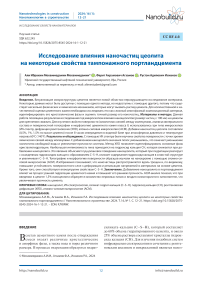Исследование влияния наночастиц цеолита на некоторые свойства тампонажного портландцемента
Автор: Мохаммедамин А.И.М., Агзамов Ф.А., Исмаков Р.А.
Журнал: Нанотехнологии в строительстве: научный интернет-журнал @nanobuild
Рубрика: Исследование свойств наноматериалов
Статья в выпуске: 1 т.16, 2024 года.
Бесплатный доступ
Введение. Визуализация микроструктуры цемента является новой областью неразрушающего исследования материала. Некоторые данные могут быть доступны с помощью одного метода, но недоступны с помощью другого, потому что существует несколько физических и химических механизмов, которые могут вызвать распад цемента. Для количественной и качественной оценки цементного камня необходимо исследовать его как сложный многофазный композиционный материал, идентифицировать его кристаллические фазы и оценить точный размер его наночастиц.
Наноцеолит, ик-спектроскопия, силикат-гидрат-кальция (c-s-h), гидроксид кальция (ch), рентгеновская дифракция (xrd), атомно-силовая микроскопия (асм)
Короткий адрес: https://sciup.org/142240632
IDR: 142240632 | УДК: 622.245 | DOI: 10.15828/2075-8545-2024-16-1-12-21
Текст научной статьи Исследование влияния наночастиц цеолита на некоторые свойства тампонажного портландцемента
Мохаммедамин А.И.М., Агзамов Ф.А., Исмаков Р.А. Исследование влияния наночастиц цеолита на некоторые свойства тампонажного портландцемента // Нанотехнологии в строительстве. 2024. Т. 16, № 1. С. 12–21. – EDN: RJYBNW.
Всостав цементного камня после отверждения смеси входят различные кристаллические и аморфные фазы, а также вода и поры различного размера. В процессе гидратации образуется гидрат- силиката-кальция (C–S–H), который составляет до 60% объема гидратированного цемента, и около 25% объема раствора составляют кристаллы гидроксида кальция (CH). Для изучения подобных систем инфракрасная спектроскопия в сочетании с рентгеновским анализом и микроскопией является полез-
ИССЛЕДОВАНИЕ СВОЙСТВ НАНОМАТЕРИАЛОВ ным инструментом для определения характеристик фаз [1, 2].
Наноцеолит – это разновидность наноматериала, которому уделялось недостаточно внимания в качестве добавки при цементировании скважин. Возможно, это связано с широкой доступностью многих наноматериалов с использованием наноцеолита в ряде других промышленных применений.
В целом, наноцеолиты представляют собой кристаллические алюмосиликаты с четко выраженной пористой структурой и размерами пор молекулярных размеров в диапазоне 0,3–2 нм (в рамках открытой трехмерной структуры из тетраэдрического кремнезема SiO4 и оксида алюминия AlO4). Наноразмер-ный цеолит был обнаружен как в вулканических, так и в осадочных породах. В промышленности цеолит зарекомендовал себя как ионообменник, катализатор и адсорбент, который используется в нефтепереработке, нефтехимии, сельском хозяйстве, управлении почвами, очистке воды и сточных вод [3]. Следовательно, формула для кристаллографической элементарной ячейки может быть использована для описания всех цеолитов; Ma/n [(AlO2)a (SiO2)b].XH2O, где M обозначает катионы, n – валентность катиона, соотношение b:a >= 1 и 5, а X – количество молей воды, захваченных внутри структуры цеолита [4].
Данное исследование направлено на оценку эффективности использования наноцеолита в качестве добавки при цементировании нефтяных скважин. Исследование было сосредоточено на анализе морфологии поверхности и структуре всех образцов с использованием методов рентгеновской дифракции, ИК-спектров и АСМ. Результаты этого исследования могут помочь в определении потенциала наноцеолитов в качестве альтернативного компонента при приготовлении цементного раствора для поддержания долговременной целостности скважины.
МАТЕРИАЛЫ И МЕТОДЫ
Для экспериментов использовался цемент для нефтяных скважин (класс G) и порошок наночастиц цеолита с размером частиц менее 100 нм, получивший название (Sapo-11 nano zeolite powder 4A) в виде белого порошка (рис. 1) с объемом пор (≥ 0,16 см3/г), удельной поверхностью (SSA ≥ 180 м2/г) и химическим составом (SiO2 ~ 6%, Al2O3 ~ 48%, и Na2O ≤ 0,2%).
Для подготовки проб использовалась деионизированная вода с соотношением вода/цемент В/Ц = 0,44. Испытываемый цементный раствор помещали в подготовленные формы (50×50×50 мм) при различных дозировках 0,5%, 1% и 1,5% наноцеолита. Образцы отверждали герметично, храня суспензию внутри медных форм с плотно прикрепленными крышками и сразу же погружая их в ванну
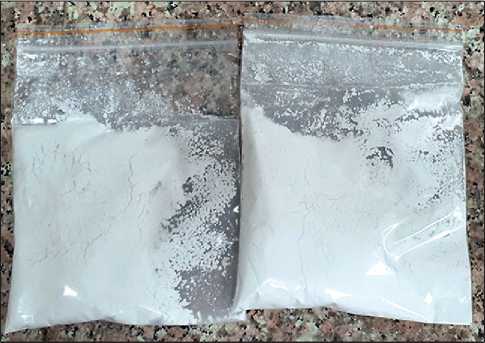
Рис. 1. Особенности внешнего вида наноцеолита
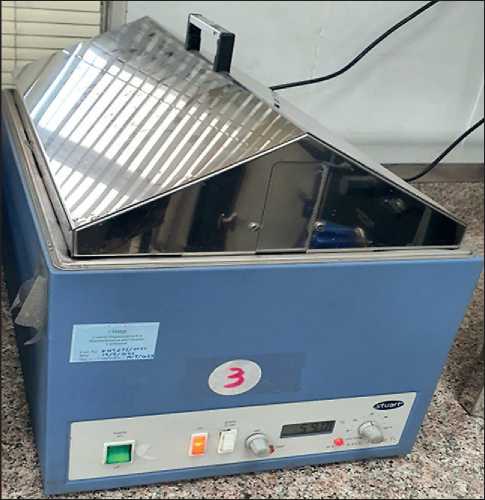
Рис. 2. Ванна для выдержки образцов цемента в воде при атмосферном давлении и температуре нагрева 60оС (140оF)
отверждения (рис. 2), при атмосферном давлении и температуре нагрева 60оC (140оF) в течение 8 часов. Весь процесс подготовки цементных смесей проводился при комнатной температуре. Процедура была выполнена в соответствии со спецификацией API Spec. 10A, 2019 г. [5].
По истечении заданного времени (8 часов) все образцы извлекали из ванны для отверждения, кубики извлекали из форм. Образцы сушили при комнатной температуре в течение 24 часов. Образцы цемента измельчались и просеивались. Исследования морфологии и микроструктуры и фазовый состав образовавшихся гидратов проводились с ис-
ИССЛЕДОВАНИЕ СВОЙСТВ НАНОМАТЕРИАЛОВ пользованием рентгеновской дифракции (XRD-6000 Shimadzu с углом падения 0,154 нм с использованием Cu-Kα-излучения), инфракрасных спектров Фурье-преобразования (ИК спектра) (Sgimadzu модель 1800, Япония) и атомно-силовой микроскопии (NaioAFM 2022, Nanosurf, Швейцария).
РЕЗУЛЬТАТЫ И ОБСУЖДЕНИЕ
Анализ цементного порошка по инфракрасным спектрам
Анализ спектроскопии твердения четырех смесей (чистый цемент и с добавками наноцеолита Z 0,5%, Z 1% и Z 1,5%) представлен ниже. Четыре образца измельчили в порошок и протестировали для изучения свойств поверхности с точки зрения химических связей между молекулами. В анализе инфракрасной спектроскопии с преобразованием Фурье горизонтальная ось инфракрасного (ИК) спектра обозначается как волновое число (1/см) и охватывает диапазон от 400 см–1 в крайнем правом углу до 4000 см–1 в крайнем левом с изменением масштаба в 2 раза при 2000 см–1. Вертикальная ось, обозначенная как коэффициент пропускания (% T) в процентах, варьируется от 0 в начале оси ординат до 100 в верхней части. Была проведена идентификация характерных пиков в инфракрасном спектре [6]. Некоторые химические элементы в цементе обладают разными функциональными группами; в том числе H2O, Al×O, Si×O, SO4–2, CO3– и OH–, активны в инфракрасном диапазоне [7]. Спектры пропускания чистого цементного раствора и цемента с различным количеством наноцеолита показаны на рис. 3 (соответственно а,б,в и г).
Из рис. 3а видно, что величина полосы 3641,60 см–1 уменьшается до 424,34 см–1, что предполагает образование геля C×S×H. Из рис. 3б, 3в и 3г с добавкамии наноцеолита величина полосы между 3641,60 см–1 и 3637,75 см–1 уменьшается до 416,62 см–1 при 0,5% наноцеолита и 420,48 см–1 при 1,5 % наноцеолита. Видно, что наименьшее значение полосы наблюдается при добавке наноцеолита 0,5%, а уменьшение значения полосы означает уменьшение свободной воды и увеличение прочности системы. Все пиковые значения приведены в табл. 1.
Спектральный анализ всех образцов камня выявил наличие широких полос в диапазоне от 3641,60 до 3637,75 см–1. Эти полосы можно отнести к перекрывающимся валентным колебаниям структурных ОН-групп портландита Ca(OH)2, возникающим в результате процесса гидратации с участием C3S и C2S. Полоса, связанная с наноцеолитом (Z 1,5%), уменьшалась по мере развития процесса гидратации, что указывает на уменьшение присутствия несвязанной воды и образование связей C–S–H [7, 8].
Полоса волн в диапазоне 3417,86–3444,87 см–1 часто связана с ОН-растяжением молекул воды, связанных с цементной матрицей. Диапазон волн цементного раствора без наноцеолита имел уменьшенный размер по сравнению с цементом, содержащим наноцеолит. Данный результат предполагает, что фаза гидратации в этом конкретном месте была более эффективной для цемента без каких-либо добавок [8, 9].
Наблюдаемые пики при 2835,36–2927,94 см–1 можно отнести к колебаниям растяжения молекулярных групп OH и CH. Эти пики свидетельствуют об уменьшении присутствия несвязанных молекул воды [10]. Связь цемента с наноцеолитом (Z 1%) стала асимметричной по отношению к другим образцам с волновым числом 2954,95 см–1 из-за появления числа волн позже, чем у остальных образцов, однако тенденции одинаковы для всех. Спектральная полоса, наблюдаемая в диапазоне волновых чисел от 1654,92 до 1658,78 см–1, может быть связана с деформационным колебанием фрагмента H–O– H внутри молекулярной структуры H2O [11]. Наблюдаемый диапазон волн 1419,61 см–1 объясняется наличием CO3–2 в чистом цементе и наноцеолите (Z 0,5%). Появление карбоната кальция (CaCO3) может быть связано с поглощением углекислого газа (CO2) из окружающей среды в процессе подготовки проб к испытаниям. Пик поглощения карбоната кальция (CaCO3) наблюдается при 1480 см–1, что можно объяснить расходом гидроксильных групп (CH) и соединений силиката кальция (C–S–H) в этой спектральной области [12,13]. При диапазоне волн 1319,31 см–1 для наноцеолита (Z 1,5%) сера (S) демонстрирует колебательные полосы, соответствующие связи (S–O) [14]. Полосы, наблюдаемые при 1118,71–1126,43 см–1, за исключением связи добавки наноцеолита (Z1%), относятся к деформационным плоскостным колебаниям связей Si–O в C3S и C3A. Это означает образование эттрингита, которое в экспериментах произошло в 8-часовом возрасте [15, 16].
Принципиальное различие между образцами цемента заключается в смещении режима растяжения Si–O с пика поглощения 968,27 см–1 в негидратиро-ванном цементе до 979,84 см–1 в гидратированном цементе [7]. Полосы в диапазоне частот 871,82 см–1 для чистого цемента, цемента с наноцеолитом 0,5% и цемента с наноцеолитом 1,5% и связи при 829,39 см–1 для чистого цемента и цемента с наноцеолитом 0,5% приписываются иону СО3–2, а внеплоскостные изгибы СО3 соответствуют колебаниям связей С–О в СН и СаСО3, возникающим в результате взаимодействия Са(ОН)2 и СО2, присутствующих в атмосфере [8, 13]. Полоса при 655,80 см–1 для цемента, содержащего
2024; 16 (1):
12–21
ИССЛЕДОВАНИЕ СВОЙСТВ НАНОМАТЕРИАЛОВ

Рис. 3. ИК-спектр цементных смесей с наноцеолитом: а – чистый цемент, б – цемент с 0,5% наноцеолита; в – цемент с 1% наноцеолита; г – цемент с 1,5% наноцеолита
ИССЛЕДОВАНИЕ СВОЙСТВ НАНОМАТЕРИАЛОВ
Таблица 1
Влияние наноцеолита на показатели ИК-спектроскопии цементного камня
|
Чистый цемент |
Z 0.5% |
Z 1% |
Z 1.5% |
Примерное описание |
|
3641,60 |
3641,60 |
3633,89 |
3637,75 |
Перекрывающиеся валентные колебания структурных ОН – групп Ca(OH)2 |
|
3417,86 |
3429,43 |
3464,15 |
3444,87 |
ОН – растяжение молекул воды, связанных с цементной матрицей |
|
2835,36 |
2850,79 |
2954,95 |
2927,94 |
Растягивающие колебания молекулярных групп O–H и C–H |
|
1658,78 |
1662,64 |
2819,21 |
1654,92 |
Вибрация изгибания H–O–H |
|
1481,33 |
1485,19 |
1797,66 |
1481,33 |
CO3–2 |
|
1419,61 |
1419,61 |
1657,92 |
1319,3 |
Связь CO3–2 и (S–O) |
|
1118,71 |
1118,71 |
1492,90 |
1126,43 |
Связи Si–O C2S и C3S |
|
968,27 |
979,84 |
1315,45 |
975,98 |
Связи Si–O |
|
871,82 |
871,82 |
1130,29 |
871,82 |
CO3–2 |
|
829,39 |
829,39 |
979,84 |
655,80 |
Изгиб CO3–2 и Si–O–Si, либо Al–O–Al |
|
667,37 |
640,37 |
875,68 |
455,20 |
Деформация SiO4 происходит в форме тетраэдра и становится более четкой |
|
470,63 |
509,21 |
455,20 |
420,48 |
|
|
424,34 |
474,49 |
|||
|
439,77 |
||||
|
416,62 |
-
1,5% наноцеолита, обусловлена асимметричным и симметричным растяжением деформационных колебаний Si–O–Si или Al–O–Al [11,17]. Наличие полосы в пределах 400-500 см–1 во всех образцах можно объяснить деформацией тетраэдра SiO4, которая становится более отчетливой. Кристаллическая структура Алита (C3S) или Белита (C2S) предполагает расположение групп SiO4 в тетраэдрическом кольце. Инфракрасные спектры всех силикатов демонстрируют два заметных пика при 1000 и 500 см–1, которые, как считается, соответствуют двум активным частотам тетраэдрической точечной группы [11, 18].
Рентгеноструктурный анализ
Метод XRD позволяет идентифицировать основные фазы кристаллической гидратации. Рентгеновские профили использовались для анализа минерального состава чистого цементного камня и затвердевшего цемента с 0,5%, 1% и 1,5% наноцеолита после их отверждения в течение 8 часов в ванне при температуре 60°C. Результаты представлены на рис. 4.
Из рентгенограмм образцов видно: гидроксид кальция Ca(OH)2, отмеченный CH, характери- стические пики 2-θ (29,561, 32,330, 34,231, 47,244, 50,918 и 54,473), силикат трикальция (Ca3SiO5, сокращенно до C3S), характеристические пики 2-θ (29,244 и 62,740), гидрат силиката дикальция (Ca2SiO4•H2O, сокращение C2S), характеристический пик 2-θ (46,989), алюминат (CaO•Al2O3, сокращенно C3A), характеристический пик 2-θ (32,730) и феррит (CaO•Al2O3•Fe2O3, отмечен C4AF), характерный пик 2-θ (33,958) [19, 20].
Наибольшая интенсивность пика при 2-θ (34,231 и 47,244) связана с гидроксидом кальция CH, который снижается при добавлении наноцеолита. Это явление проясняет пуццолановое поведение наноцеолита, который взаимодействует с осажденным гидроксидом кальция при гидратации с образованием C–S–H, снижает содержание гидроксида кальция в слоистой структуре и повышает C–S–H. В результате добавления наноцеолита в портландцемент отмечено влияние на ранний процесс гидратации цементного камня и улучшение его прочности на раннем этапе. Кроме того, возможность появления карбоната кальция CaCO3 может иметь место из-за частичной карбонизации портландита. Поскольку смеси готовились одновременно для всех образцов цемента, случайная карбонизация за счет
ИССЛЕДОВАНИЕ СВОЙСТВ НАНОМАТЕРИАЛОВ
2024; 16 (1):
12–21
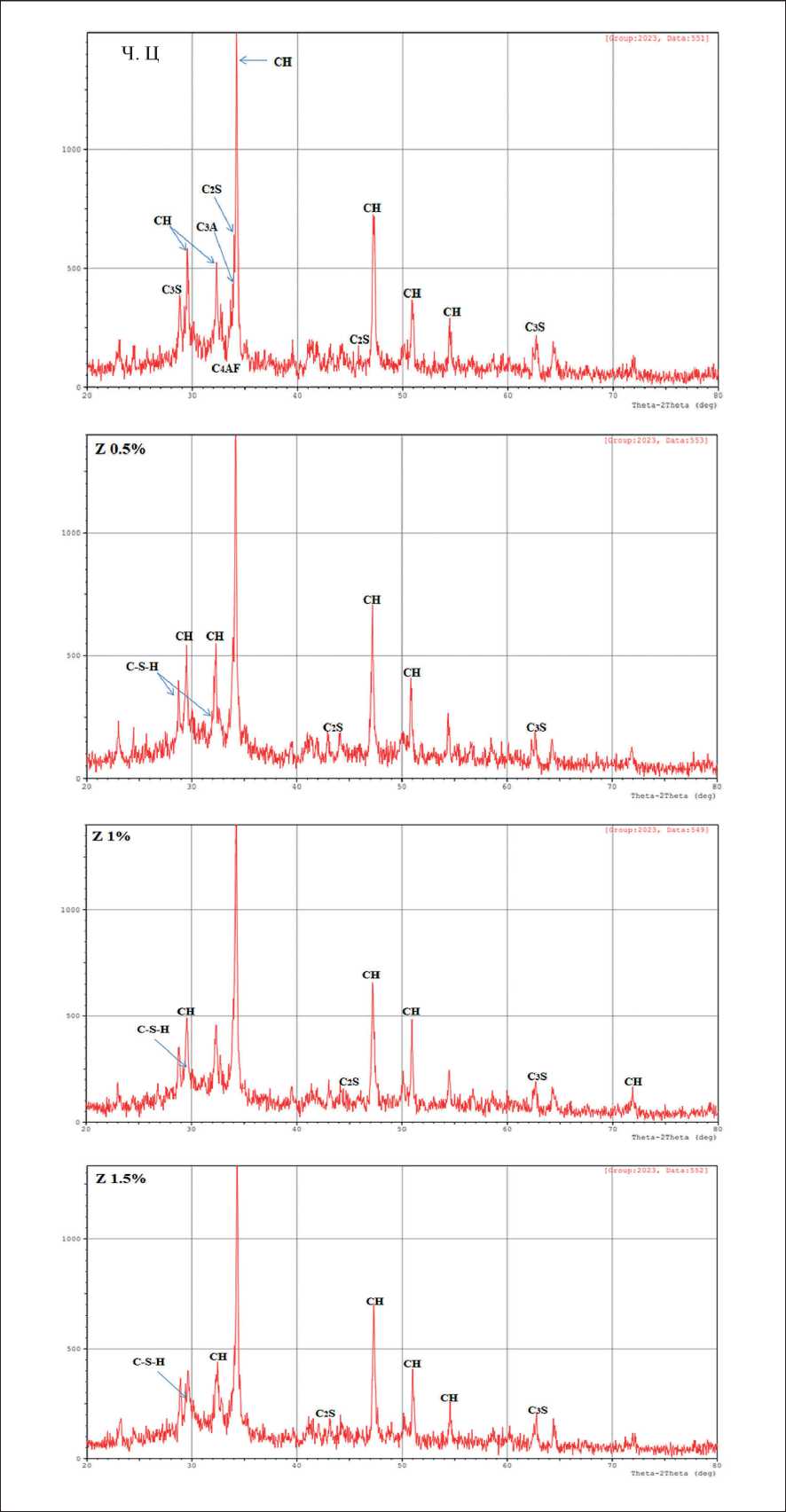
Рис. 4. Рентгенограммы четырех образцов цементного камня с наноцеолитом и без него
ИССЛЕДОВАНИЕ СВОЙСТВ НАНОМАТЕРИАЛОВ реакции гидроксида кальция с углекислым газом атмосферы происходила в одинаковой степени для всех образцов. Это наблюдение было также подтверждено анализом ИК-спектра.
Из-за наличия лишь ограниченного числа широких и слабых дифракционных максимумов на рентгенограммах C–S–H эту фазу часто называют рентгеноаморфной. Этот термин предполагает, что кристаллическая структура C–S–H не обладает каким-либо организованным расположением на больших расстояниях [21]. Однако, согласно опубликованным данным, рентгенограммы (XRD) C–S–H постоянно демонстрируют пики под определенными углами в 2-θ (7,4, 16,7, 29,1, 32, 49,8, 55, 66,8), которые в основном асимметричны [22, 23]. В соответствии с этим и из таблицы данных XRD (обработка основных данных) для образцов были записаны 4 картины C–S–H, 2 картины в наноцеолите 0,5%, и остальные 2 картины появились в наноцеолите 1% и 1,5% с интегрированной интенсивностью. Материал часто называют гелем, а не кристаллическим веществом из-за отсутствия регулярной структуры, которую можно увидеть с помощью рентгеновской дифракции. Его состав может варьироваться, но обычно он содержит
примерно в два раза больше CaO, чем SiO2, а также небольшое количество воды [24].
АСМ-анализ поверхности наноструктур
Для исследования топографии и морфологии поверхности в наномасштабе исследуемых образцов использовалась атомно-силовая микроскопия. 3D-изображение шероховатости поверхности образцов представлено на рис. 5.
Наночастицы воздействуют на структуры цемента в образцах, вызывая образование многогранных агломератов. Спектры АСМ-топографии образцов показывают наличие грязевых трещин над равномерно гладким и плоским поверхностным слоем, который покрывают нанообъемные структуры, включающие частицы наноцеолита. При ближайшем рассмотрении на этих изображениях видно, что наночастицы распространяются по этим трещинам и, по-видимому, повышают устойчивость поверхностного слоя к деформации и релаксации напряжений в материалах на основе цемента. Кроме того, они способствуют вязкоупругому поведению C–S–H, о чем свидетельствует топография.
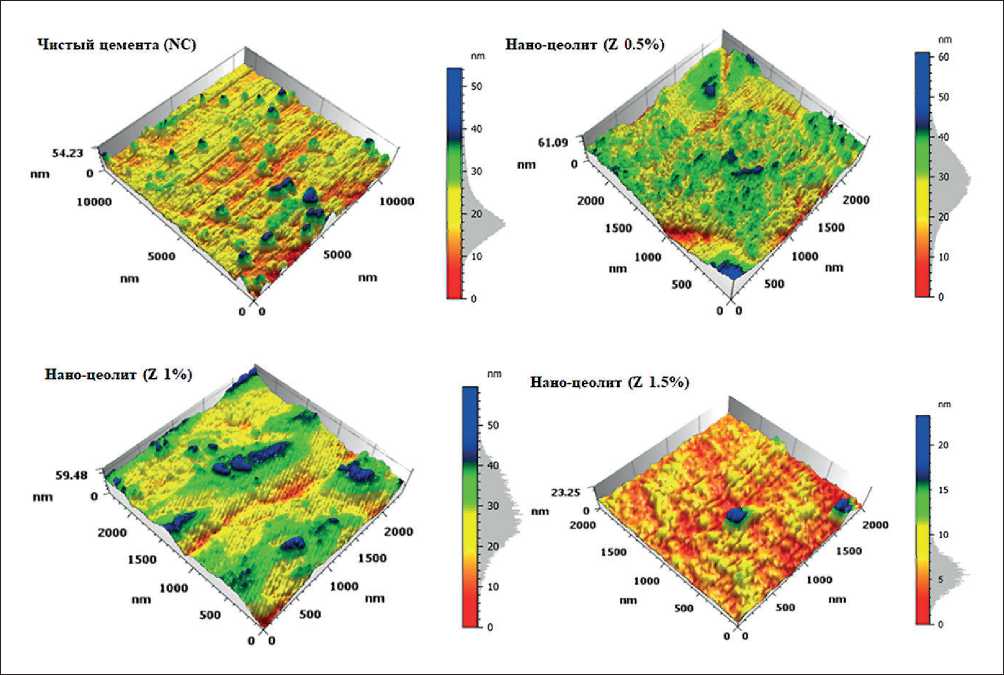
Рис. 5. АСМ-изображения образцов цемента без наноцеолита (чистый цемент) и с наноцеолитом (0,5%, 1%, 1,5%)
ИССЛЕДОВАНИЕ СВОЙСТВ НАНОМАТЕРИАЛОВ
На рис. 5 видно, что шероховатость поверхности имеет вид сложной структуры с множеством пиков и долин разного размера и расстояния друг от друга. В соответствии с ISO 25178 по шероховатости поверхности, высотными параметрами, описывающими морфологию поверхности, являются: (Sq) среднеквадратичное значение высоты, (Ssk) асимметрия поверхности ограниченного масштаба, (Sku) эксцесс поверхности ограниченного масштаба, (Sp) максимальная высота пика поверхности ограниченного масштаба, (Sv) максимальная высота провала поверхности ограниченного масштаба, (Sz) максимальная высота поверхности ограниченного масштаба, (Sa) арифметическое среднее значение высоты поверхности ограниченного масштаба. В табл. 2 приведены значения параметров.
Расстояние между различными компонентами текстуры может быть описано с помощью параметров Sa и Sq, которые оптимизированы для описания пиков и долин поверхности [25]. Аналогично значение Ssk отражает степень смещения формы шероховатости. Значение Sku профиля шероховатости показывает, насколько он остроконечен. Sp, Sv и Sz – параметры, получаемые путем анализа абсолютных наибольших и наименьших точек, обнаруженных на исследуемой поверхности [25, 26]. Из табл. 2 следует, что при увеличении значений Sa и Sq для поверхности размер зерен цемента будет высоким. Это можно заметить при использовании наноцеолита Z 1% по поверхностным пикам и долинам на рис. 5 и значениям высоты в табл. 2. Кроме того, низкие значения Sa и Sq могут способствовать уменьшению пористости матрицы и повышению ее прочности. Такое проявление в матрице с наноцеолитом 1,5% хорошо видно как на рис., так и по наименьшим значениям Sa и Sq в табл. [25, 27]. Симметрия пиков и до-
лин описывается Ssk. Если Ssk = 0, то пики и долины равномерно распределены вокруг средней плоскости. Если Ssk < 0, то на поверхности преобладают долины (Ssk в наноцеолите Z 0,5% меньше 0). Напротив, если Ssk > 0, то на поверхности преобладают пики Sku, а это метрика, количественно характеризующая степень остроты поверхности. В общем случае, когда Sku = 3, это свидетельствует о том, что поверхность имеет сбалансированное распределение как гладких, так и зазубренных пиков и долин. Если значение Sku меньше 3, то поверхность состоит в основном из уплощенных вершин и долин с относительно значительной кривизной по краям. Это может свидетельствовать о меньшей вероятности зарождения трещин под действием напряжений по сравнению с поверхностями, имеющими острые пики и долины. И наоборот, если Sku больше 3, то поверхность имеет четко выраженные пики и долины с очень малой кривизной по краям [27, 28].
ЗАКЛЮЧЕНИЕ
Результаты показали, что при добавлении наноцеолита происходит снижение содержания гидроксида кальция СН. Это явление объясняет пуццолановое поведение наноцеолита, который взаимодействует с осажденным гидроксидом кальция при гидратации с образованием C–S–H, уменьшает слоистую структуру гидроксида кальция и повышает количество C–S–H. Таким образом, добавление наноцеолита в портландцемент влияет на процесс ранней гидратации цементного камня и повышает его раннюю прочность. АСМ-анализ показал, что при введении 1,5% наноцеолита в цемент образуется множество нерегулярных пиков и долин наполнителя с низкой пористостью, что повышает прочность цемента.
Таблица 2
Параметры шероховатости поверхности для цемента и добавок
|
Параметры |
Чистый цемент |
Z 0.5% |
Z 1% |
Z 1.5% |
|
Sq (nm) |
5,847 |
7,137 |
7,655 |
2,332 |
|
Ssk |
1,225 |
–0,2093 |
0,03682 |
2,501 |
|
Sku |
5,876 |
3,554 |
2,787 |
15,24 |
|
Sp (nm) |
35,00 |
32,55 |
30,72 |
17,36 |
|
Sv (nm) |
19,24 |
28,53 |
28,76 |
5,899 |
|
Sz (nm) |
54,23 |
61,09 |
59,48 |
23,25 |
|
Sa (nm) |
4,243 |
5,581 |
6,216 |
1,549 |

ИССЛЕДОВАНИЕ СВОЙСТВ НАНОМАТЕРИАЛОВ
Список литературы Исследование влияния наночастиц цеолита на некоторые свойства тампонажного портландцемента
- A. Peled, J. Castro, W.J. Weiss. Atomic force and lateral force microscopy (AFM and LFM) examinations of cement and cement hydration products. Elsevier, Cement and Concrete Composites. 2013: 36: 48-55. https://doi.org/10.1016/j.cemconcomp.2012.08.021
- G. Bell, J. Bensted, F. P. Glasser. Characterization of hydrothermally treated calcium silicate and oilwell cement hydration products. Advances in Cement Research. 1989: 2(6): 61-72.
- E. Koohsaryan, Mansoor A. Nanosized and hierarchical zeolites: A short review. Chinese Journal of Catalysis. 2016: 37: 447-467. https://doi.org/10.1016/S1872-2067(15)61038-5
- Luke et al., Zeolite-containing cement composition. Patent, US 2004/0112600 A1.
- API specification 10A, Cements and Materials for Well Cementing. 25th edition, 2019.
- Jemimah C. Milton, Prince A. Gnanaraj Compressive Strength of Concrete with Nano Cement. IntechOpen; 2021.
- Suman L. Shrestha. Characterization of Some Cement Samples of Nepal Using FTIR Spectroscopy. IJARCS. 2018; 5(7): 19-23. DOI: http://dx.doi.org/10.20431/2349-0403.0507004
- H. Biricika, N. Sarierb. Comparative Study of the Characteristics of Nano Silica – Silica Fume – and Fly Ash – Incorporated Cement Mortars. Materials Research. 2014; 17(3). https://doi.org/10.1590/S1516-14392014005000054
- Victor H. J. M. dos Santos, D. Pontin, Gabriela G. D. Ponzi, A. Sofia de Guimaraes e Stepanha, R. B. Martel, Marta K. Schütz, Sandra Mara O. Einloft, F. D. Vecchia. Application of Fourier Transform infrared spectroscopy (FTIR) coupled with multivariate regression for calcium carbonate (CaCO3) quantification in cement. Construction and Building Materials. 2021; 3(13): 125413. https://doi.org/10.1016/j.conbuildmat.2021.125413
- Y. R. Zhang, X. M. Kong, Z. B. Lu, Zi C. Lu, S. S. Hou. Effects of the charge characteristics of polycarboxylate superplasticizers on the adsorption and the retardation in cement pastes. Cement and Concrete Research. 2015; 67: 184-196. https://doi.org/10.1016/j.cemconres.2014.10.004
- Ping Yu, R. J. Kirkpatrick, B. Poe, Paul F. McMillan, X. Cong. Structure of Calcium Silicate Hydrate (C-S-H): Near-, Mid-, and Far-Infrared Spectroscopy. Journal of the American Ceramic Society. 1999; 82(3): 742-748.
- Omotayo O., Himanshu M., Ramadan A., Subhash S., Samuel O., Shokrollah H., G. DeBruijn, Winton C., Dave S. Degradation of well cement in HPHT acidic environment: Effects of CO2 concentration and pressure. Cement and Concrete Composites. 2016: 74: 54-70. https://doi.org/10.1016/j.cemconcomp.2016.09.006
- D. Vaiciukyniene, G. Skipkiunas, M. Dauksys, V. Sasnauskas. Cement hydration with zeolite-based additive. chemija. 2013; 24(4): 271-278. https://www.researchgate.net/publication/259580412
- M.J. Varas, M. Alvarez de Buergo, R. Fort. Natural cement as the precursor of Portland cement: Methodology for its identification. Cement and Concrete Research. 2005; 35: 2055-2065.
- A. Mohammeda, S. Rafiq, W. Mahmood, R. Noaman, H. AL-Darkazali, K. Ghafor, W. Qadir. Microstructure characterizations, thermal properties, yield stress, plastic viscosity and compression strength of cement paste modified with nanosilica. Journal of Materials Research and Technology. 2020; 9(5): 10941-10956. https://doi.org/10.1016/j.jmrt.2020.07.083
- Z. Ou, B. Ma, Sh. Jian. Comparison of FT-IR, Thermal Analysis and XRD for Determination of Products of Cement Hydration. Advanced Materials Research. 2011; (168-170): 518-522. https://doi.org/10.4028/www.scientific.net/AMR.168-170.518
- R. Ma, L. Guo, W. Sun, Zh. Rong. Well-Dispersed Silica Fume by Surface Modification and the Control of Cement Hydration. Hindawi. 2018: Article ID 6184105. https://doi.org/10.1155/2018/6184105
- L. Fernández-Carrasco, D. Torrens-Martín, L. M. Morales, S. Martínez-Ramírez. Infrared Spectroscopy in the Analysis of Building and Construction Materials. Infrared Spectroscopy – Materials Science, Engineering and Technology. https://www.intechopen.com/
- ASTM C 1365 - 98, Standard Test Method for Determination of the Proportion of Phases in Portland cement and Portland-Cement Clinker Using X-Ray Powder Diffraction Analysis, 1998.
- Taylor H.F.W. Cement chemistry. Thomas Telford, 2nd edition; 1997.
- S. Grangeon, F. Claret, Y. Linard, Ch. Chiaberge. X-ray diffraction: a powerful tool to probe and understand the structure of nanocrystalline calcium silicate hydrates. Acta Cryst. 2013; B69: 465-473.
- K. Garbev, G. Beuchle, M. Bornefeld, L. Black, P. Stemmermann. Cell Dimensions and Composition of Nanocrystalline Calcium Silicate Hydrate Solid Solutions. Part 1: Synchrotron-Based X-Ray Diffraction. Journal of the American Ceramic Society. 2008; 91(9): 3005- 3014.
- K. Garbev, M. Bornefeld, G. Beuchle, P. Stemmermann. Cell Dimensions and Composition of Nanocrystalline Calcium Silicate Hydrate Solid Solutions. Part 2: X-Ray and Thermogravimetry Study. Journal of the American Ceramic Society. 2008: 91(9): 3015-3023.
- Peter C. Hewlett, Martin Liska, Lea’s Chemistry of Cement and Concrete. Elsevier, 5th Edition; 2019.
- L. Sadowski, S. Czarnecki, J. Hoła. Evaluation of the height 3D roughness parameters of concrete substrate and the adhesion to epoxy resin. International Journal of Adhesion and Adhesives. 2016: 67: 3-13. https://doi.org/10.1016/j.ijadhadh.2015.12.019
- Keyence Corporation of America, Introduction to Surface Roughness Measurement; 2012. https://www.keyence.com/
- Z. Zhu, Sh. Lou, C. Majewski. Characterisation and correlation of areal surface texture with processing parameters and porosity of High Speed Sintered parts. Additive Manufacturing. 2020; 36: 101402. https://doi.org/10.1016/j.addma.2020.101402
- Richard Leach. Characterisation of Areal Surface Texture. Springer-Verlag Berlin Heidelberg; 2013.

